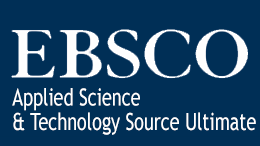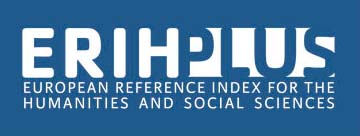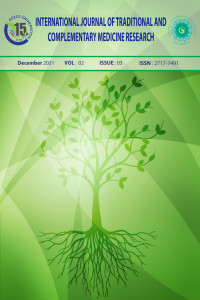Abstract
Supporting Institution
YOKTUR
References
- 1.http:// apps. who. int/ iris/ bitstream/ 10665/ 92455/ 1/ 9789241506090_eng. pdf? ua=1 2013. Date of access: 08/10/2021.
- 2. https://apps.who.int/iris/handle/10665/67163. Date of access: 08/10/2021.
- 3. Zülfünaz Ö, Turan GB, Bakır E. Dahiliye Polikliniğine Başvuran Hastaların Geleneksel ve Tamamlayıcı Tıbba Karşı Tutumları ve Etkileyen Faktörler. Sağlık Profesyonelleri Araştırma Dergisi. 2020;2(3):102-112.
- 4. Singh A, Kamath A. Attitude of Medical Students and Doctors towards Complementary, Alternative and Integrative Medicine: A Single-Center, Questionnaire-Based Study. J Pharmacopuncture. 2021;24(2):84-90.
- 5. Samara AM, Barabra ER, Quzaih HN, Zyoud SH. Use and acceptance of complementary and alternative medicine among medical students: a cross sectional study from Palestine. BMC Complement Altern Med. 2019;19(1):78.
- 6. Kavadar G, Eroğlu Demir S, Aytekin E, Akbal Y. Use of traditional and complementary medicine for musculoskeletal diseases. Turk J Med Sci. 2019;49(3):809-814.
- 7. Tangkiatkumjai M, Boardman H, Walker DM. Potential factors that influence usage of complementary and alternative medicine worldwide: a systematic review. BMC Complement Med Ther. 2020;20(1):363.
- 8. Berna F, Göritz AS, Mengin A, Evrard R, Kopferschmitt J, Moritz S. Alternative or complementary attitudes toward alternative and complementary medicines. BMC Complement Altern Med. 2019;19(1):83.
- 9. Mwaka AD, Tusabe G, Garimoi CO, Vohra S, Ibingira C. Integration of traditional and complementary medicine into medical school curricula: a survey among medical students in Makerere University, Uganda. BMJ Open. 2019;9(9):e030316.
- 10. Misawa J, Ichikawa R, Shibuya A, Maeda Y, Arai I, Hishiki T, Kondo Y. The impact of uncertainty in society on the use of traditional, complementary and alternative medicine: a comparative study on visits to alternative/traditional/folk health care practitioners. BMC Complement Altern Med. 2019;19(1):251.
- 11. Resmi Gazete. Geleneksel ve Tamamlayıcı Tıp Uygulamaları Yönetmeliği. 27.10.12014; Sayı: 29158. Date of Access: 20/11/2021.
- 12. Grace R, Vaz J, Da Costa J. Traditional medicine use in Timor-Leste. BMC Complement Med Ther. 2020;20(1):165.
- 13. Köse E, Ekerbiçer HÇ, Erkorkmaz Ü. Complementary, Alternative and Conventional Medicine Attitude Scale: Turkish Validity Reliability Study. Sakarya Tıp Dergisi. 2018;8(4):726-736.
- 14. Şensoy N, Özdinç Ş, Yılmaz O, Çetin MD, Dilara T, Doğantekin P, Erden B, Güler K. Üniversite Hastanesine Başvuran Hastaların Tamamlayıcı ve Alternatif Tedavi Kullanımına Yönelik Tutum ve Davranışları. Kocatepe Tıp Dergisi. 2020;21(3):258-263.
- 15. Odabaş ÖK, Ağadayı E. Aile Hekimliği Polikliniğine Başvuran Hastaların Geleneksel ve Tamamlayıcı Tıp Uygulamaları Hakkında Bilgi ve Davranışları. TJFMPC. 2021;15(1):121-128.
- 16. Karataş Y, Khan Z, Bilen Ç, Boz A, Özagil ESG, Abussuutoğlu AB, Rahman H. Traditional and Complementary Medicine use and beliefs during COVID-19 outbreak: A cross-sectional survey among the general population in Turkey. Adv Integr Med. 2021.
- 17. Akan H, Izbirak G, Kaspar EC, Kaya CA, Aydin S, Demircan N, Bucaktepe PG, Ozer C, Sahin HA, Hayran O. Knowledge and attitudes towards complementary and alternative medicine among medical students in Turkey. BMC Complement Altern Med. 2012;12:115.
- 18. Dursun S, Vural B, Keskin B, Kaçar H, Beyhan A, Kadıoğlu H. The relationship between traditional/complementary medical attitude and health literacy and health perception in adults. J Public Health Nurs. 2019;1(1):1-10.
- 19. Avci DK. The use of traditional and complementary medicine among diabetes patients, and the awareness and attitudes of physicians. J Pak Med Assoc. 2018;68(11):1650-1654.
- 20. Horneber M, Bueschel G, Dennert G, Less D, Ritter E, Zwahlen M. How many cancer patients use complementary and alternative medicine: a systematic review and metaanalysis. Integr Cancer Ther. 2012;11(3):187-203.
- 21. Lakshmi JK, Nambiar D, Narayan V, Sathyanarayana TN, Porter J, Sheikh K. Cultural consonance, constructions of science and co-existence: a review of the integration of traditional, complementary and alternative medicine in low- and middle-income countries. Health Policy Plan. 2015;30(8):1067-1077.
- 22. Öztürk YE, Dömbekci HA, Ünal SN. Geleneksel Tamamlayıcı ve Alternatif Tıp Kullanımı. Bütünleyici ve Anadolu Tıbbı Dergisi. 2020;1(3):23-35.
- 23. Ötegen E, Başer DA, Kecik H, Aksoy H, Fidanci I. Attitudes and Behaviors of Adults on Interventional (Invasive) Traditional Medicine Methods: A Descriptive Study. IJTCMR. 2021;2(02):62-68.
Determination of Knowledge, Attitudes and Behaviors towards Traditional and Complementary Medicine in Patients Applying to Pamukkale University Medical Faculty Hospital Polyclinics
Abstract
Objective: The aim of research was to investigate the attitudes and behaviors towards traditional and complementary medicine methods, the use of which has increased in recent years, in individuals admitted to the hospital.
Material-Method: The descriptive study was performed by applying a questionnaire to 276 people. The questionnaire included questions about the sociodemographic characteristics of the participants, their knowledge, attitudes and behaviors about traditional complementary medicine methods, and the Complementary, Alternative, and Conventional Medicine Attitude Scale. Data were analyzed with the Statistical Package for the Social Sciences version 15. Chi-square test, Mann-Whitney U and Kruskall-Wallis H tests were used in the comparison of traditional and complementary medicine attitudes and behaviors with sociodemographic characteristics. p<0.05 was considered significant.
Results: 33% of respondents had applied at least one traditional complementary medicine method. The most commonly used methods were cupping (n=40), phytotherapy (n=34) and acupuncture (n=17). The mean score of scale was found to be 109.05±15.44. The mean score of the individuals aged 45 and over is higher than the other ages and is 102.7±17.2 (p<0.048). A statistically significant difference was found between the use of at least one traditional and complementary method and the variables of age, marital status, place of residence for the longest time, and perceived health (p<0.05).
Conclusion: TCM methods are known to the majority of people who visit polyclinics. Their attitudes towards traditional and complementary medicine are quite close to positive. Physicians should question whether their patients use traditional methods.
References
- 1.http:// apps. who. int/ iris/ bitstream/ 10665/ 92455/ 1/ 9789241506090_eng. pdf? ua=1 2013. Date of access: 08/10/2021.
- 2. https://apps.who.int/iris/handle/10665/67163. Date of access: 08/10/2021.
- 3. Zülfünaz Ö, Turan GB, Bakır E. Dahiliye Polikliniğine Başvuran Hastaların Geleneksel ve Tamamlayıcı Tıbba Karşı Tutumları ve Etkileyen Faktörler. Sağlık Profesyonelleri Araştırma Dergisi. 2020;2(3):102-112.
- 4. Singh A, Kamath A. Attitude of Medical Students and Doctors towards Complementary, Alternative and Integrative Medicine: A Single-Center, Questionnaire-Based Study. J Pharmacopuncture. 2021;24(2):84-90.
- 5. Samara AM, Barabra ER, Quzaih HN, Zyoud SH. Use and acceptance of complementary and alternative medicine among medical students: a cross sectional study from Palestine. BMC Complement Altern Med. 2019;19(1):78.
- 6. Kavadar G, Eroğlu Demir S, Aytekin E, Akbal Y. Use of traditional and complementary medicine for musculoskeletal diseases. Turk J Med Sci. 2019;49(3):809-814.
- 7. Tangkiatkumjai M, Boardman H, Walker DM. Potential factors that influence usage of complementary and alternative medicine worldwide: a systematic review. BMC Complement Med Ther. 2020;20(1):363.
- 8. Berna F, Göritz AS, Mengin A, Evrard R, Kopferschmitt J, Moritz S. Alternative or complementary attitudes toward alternative and complementary medicines. BMC Complement Altern Med. 2019;19(1):83.
- 9. Mwaka AD, Tusabe G, Garimoi CO, Vohra S, Ibingira C. Integration of traditional and complementary medicine into medical school curricula: a survey among medical students in Makerere University, Uganda. BMJ Open. 2019;9(9):e030316.
- 10. Misawa J, Ichikawa R, Shibuya A, Maeda Y, Arai I, Hishiki T, Kondo Y. The impact of uncertainty in society on the use of traditional, complementary and alternative medicine: a comparative study on visits to alternative/traditional/folk health care practitioners. BMC Complement Altern Med. 2019;19(1):251.
- 11. Resmi Gazete. Geleneksel ve Tamamlayıcı Tıp Uygulamaları Yönetmeliği. 27.10.12014; Sayı: 29158. Date of Access: 20/11/2021.
- 12. Grace R, Vaz J, Da Costa J. Traditional medicine use in Timor-Leste. BMC Complement Med Ther. 2020;20(1):165.
- 13. Köse E, Ekerbiçer HÇ, Erkorkmaz Ü. Complementary, Alternative and Conventional Medicine Attitude Scale: Turkish Validity Reliability Study. Sakarya Tıp Dergisi. 2018;8(4):726-736.
- 14. Şensoy N, Özdinç Ş, Yılmaz O, Çetin MD, Dilara T, Doğantekin P, Erden B, Güler K. Üniversite Hastanesine Başvuran Hastaların Tamamlayıcı ve Alternatif Tedavi Kullanımına Yönelik Tutum ve Davranışları. Kocatepe Tıp Dergisi. 2020;21(3):258-263.
- 15. Odabaş ÖK, Ağadayı E. Aile Hekimliği Polikliniğine Başvuran Hastaların Geleneksel ve Tamamlayıcı Tıp Uygulamaları Hakkında Bilgi ve Davranışları. TJFMPC. 2021;15(1):121-128.
- 16. Karataş Y, Khan Z, Bilen Ç, Boz A, Özagil ESG, Abussuutoğlu AB, Rahman H. Traditional and Complementary Medicine use and beliefs during COVID-19 outbreak: A cross-sectional survey among the general population in Turkey. Adv Integr Med. 2021.
- 17. Akan H, Izbirak G, Kaspar EC, Kaya CA, Aydin S, Demircan N, Bucaktepe PG, Ozer C, Sahin HA, Hayran O. Knowledge and attitudes towards complementary and alternative medicine among medical students in Turkey. BMC Complement Altern Med. 2012;12:115.
- 18. Dursun S, Vural B, Keskin B, Kaçar H, Beyhan A, Kadıoğlu H. The relationship between traditional/complementary medical attitude and health literacy and health perception in adults. J Public Health Nurs. 2019;1(1):1-10.
- 19. Avci DK. The use of traditional and complementary medicine among diabetes patients, and the awareness and attitudes of physicians. J Pak Med Assoc. 2018;68(11):1650-1654.
- 20. Horneber M, Bueschel G, Dennert G, Less D, Ritter E, Zwahlen M. How many cancer patients use complementary and alternative medicine: a systematic review and metaanalysis. Integr Cancer Ther. 2012;11(3):187-203.
- 21. Lakshmi JK, Nambiar D, Narayan V, Sathyanarayana TN, Porter J, Sheikh K. Cultural consonance, constructions of science and co-existence: a review of the integration of traditional, complementary and alternative medicine in low- and middle-income countries. Health Policy Plan. 2015;30(8):1067-1077.
- 22. Öztürk YE, Dömbekci HA, Ünal SN. Geleneksel Tamamlayıcı ve Alternatif Tıp Kullanımı. Bütünleyici ve Anadolu Tıbbı Dergisi. 2020;1(3):23-35.
- 23. Ötegen E, Başer DA, Kecik H, Aksoy H, Fidanci I. Attitudes and Behaviors of Adults on Interventional (Invasive) Traditional Medicine Methods: A Descriptive Study. IJTCMR. 2021;2(02):62-68.
Details
| Primary Language | English |
|---|---|
| Subjects | Traditional, Complementary and Integrative Medicine |
| Journal Section | Research Articles |
| Authors | |
| Publication Date | December 20, 2021 |
| Submission Date | October 11, 2021 |
| Published in Issue | Year 2021 Volume: 2 Issue: 3 |
Cite
Cited By
Investigation of The Relationship Between Health Literacy and Attitude Towards Traditional and Complementary Medicine among Health Licensor Candidates
International Journal of Traditional and Complementary Medicine Research
https://doi.org/10.53811/ijtcmr.1526518
IJTCMR
International Journal of Traditional and Complementary Medicine Research





